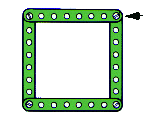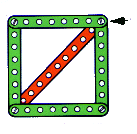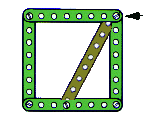Chassis Flex & Rigidity
A rigid chassis is the backbone of any high performance car design. Chassis flex allows alignment settings to wander and prevents sway bars from performing their weight-transfer function. Rigidity in chassis design is typically achieved through the shape of the structure.
In most designs, triangulation is the basic tool for creating rigidity through shape.
A simple example illustrates how triangulation creates rigidity through shape;
 When forces are applied to a four-sided structure with corner pivots it can be easily forced out of shape. This structure is non-rigid.
When forces are applied to a four-sided structure with corner pivots it can be easily forced out of shape. This structure is non-rigid.
By adding a diagonal member, connected corners are held at a fixed distance. They can’t be spread apart or moved closer together. Despite pivots for corners, the structure cannot be be forced out of shape, and is rigid. Notice that the additional member has formed two triangles in the structure. This is called triangulation.
Despite pivots for corners, the structure cannot be be forced out of shape, and is rigid. Notice that the additional member has formed two triangles in the structure. This is called triangulation.
In the simple example the shape creates rigidity, not the strength of the material. Pivots in the corners ensure individual structural members are not subjected to bending loads. Structural members are placed in pure tension or pure compression.
The following is not an example of triangulation.  Notice the diagonal member connects to the center of the bottom member and attempts to bend it when force is applied to a corner. Although more rigid than the simple four sided structure, this type of design is limited by the strength and rigidity of the bottom member.
Notice the diagonal member connects to the center of the bottom member and attempts to bend it when force is applied to a corner. Although more rigid than the simple four sided structure, this type of design is limited by the strength and rigidity of the bottom member.
The diagonal member exerts a bending force on the bottom member. The structure can be forced out of shape and is non-rigid. This is not an example of proper triangulation.
Lightweight And Strong
Because properly triangulated structural members are not subjected to bending loads they can be made of relatively lightweight and weak materials. Triangulation allows a chassis to be rigid and lightweight at the same time.
Notice that despite having a single diagonal, the triangulated structure is rigid for forces applied to any corner in any direction in the plane of triangulation. Triangulation does not provide rigidity to forces that are applied to structural members mid-span.
A visible example of triangulation put to practice on a Porsche 911 is the Elephant Racing Triangulated Strut Brace. The strut towers, trunk floor and main strut brace form a non-rigid four-sided structure. The addition of the diagonal brace creates triangulation and rigidity of the shock towers.
Other examples of triangulation can be seen in properly designed roll cages and roll bars.
Harder to see is triangulation in unit body chassis design, yet it is used throughout. Sheet metal forms the triangulated structural members.













